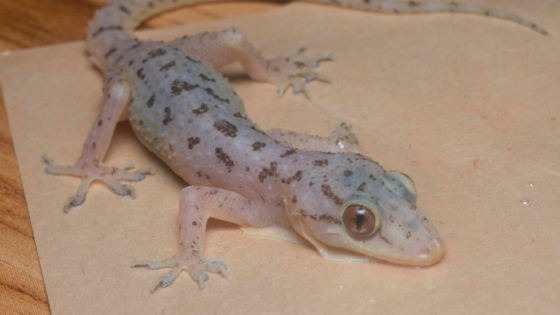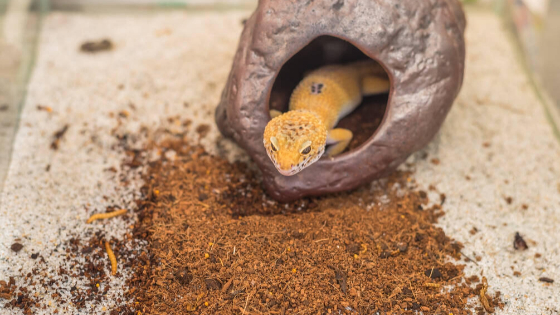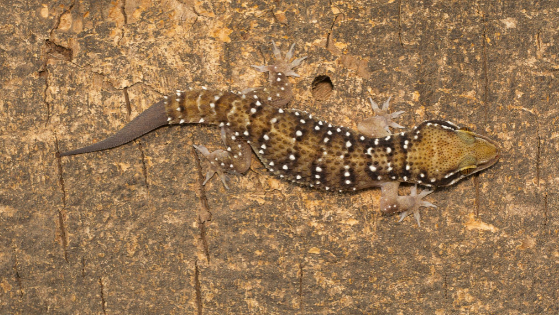
The invasion of invasive Mediterranean house geckos in the United States poses a significant ecological and economic challenge.
These geckos, known for their distinctive physical features and adaptability to various habitats, have been steadily expanding their range within the country. From Pennsylvania to Tennessee and Indiana, reports of sightings have raised concerns about the potential impact of these geckos on native species and ecosystems.
In order to effectively manage and prevent further spread, it is essential to delve into their behavior, reproductive patterns, and strategies for control. In this article, we explore the invasive nature of the Mediterranean house gecko and discuss potential strategies for mitigating their impact.
Key Takeaways
- The Mediterranean house gecko is a small reptile native to the Mediterranean region but has successfully expanded its range beyond.
- It thrives in urban or suburban areas, nesting in man-made structures such as attics and baseboards.
- The gecko is a skilled nocturnal predator, using its sticky toe pads to effortlessly scale vertical surfaces and hunt down prey.
- The gecko’s adaptability and invasive nature pose challenges for local ecosystems, potentially displacing native species and disrupting ecological balance.
Background and Physical Characteristics
The Mediterranean house gecko (Hemidactylus turcicus) is a small reptile measuring 10-13cm (4-5 inches) in length, characterized by its distinctive physical features. This gecko possesses sticky toe pads, vertical pupils, and large eyes without eyelids. Its body and limb sizes are moderate, with variable digit length. It has a rounded snout, a slightly concave forehead, and an oval ear opening.
Native to the Mediterranean region, the Mediterranean house gecko has spread over much of the world and established stable populations. It is commonly found in countries with Mediterranean climates and has also been discovered in the Southwestern and Southern United States. This adaptable species can thrive in a wide range of habitats near human presence, including old brick buildings, mountain cliffs, caves, and trash piles. In urban or suburban areas, they can often be found nesting in attics or under baseboards of buildings.
The Mediterranean house gecko is nocturnal and emits a high-pitched call. It exhibits aggressive behavior towards juveniles and is a voracious predator of moths and small roaches. These geckos are attracted to outdoor lights in search of prey and are also drawn by the call of the male decorated cricket. They reach sexual maturity within four months to a year and engage in copulatory biting to increase fertilization success. The breeding season for Mediterranean house geckos is from April to August, with an average clutch size of two.
Geographic Distribution

Having established stable populations across much of the world, the Mediterranean house gecko can be found in various countries with Mediterranean climates as well as in the Southwestern and Southern United States. Its geographic distribution is characterized by the following:
- Clinging to old brick buildings, the gecko can be seen stealthily navigating through cracks and crevices.
- Scaling mountain cliffs and inhabiting caves, it adapts to a variety of natural environments.
- Surprisingly, the gecko also thrives in man-made habitats such as trash piles and attics.
- Its presence is particularly pronounced in urban or suburban areas, where it takes advantage of human settlement.
- Attracted to outdoor lights, the gecko ventures out in search of prey, mesmerizing onlookers with its agile movements.
With its ability to adapt to different habitats, the Mediterranean house gecko has successfully expanded its range beyond its native Mediterranean region, making it a formidable invader in the United States.
Habitat Preferences
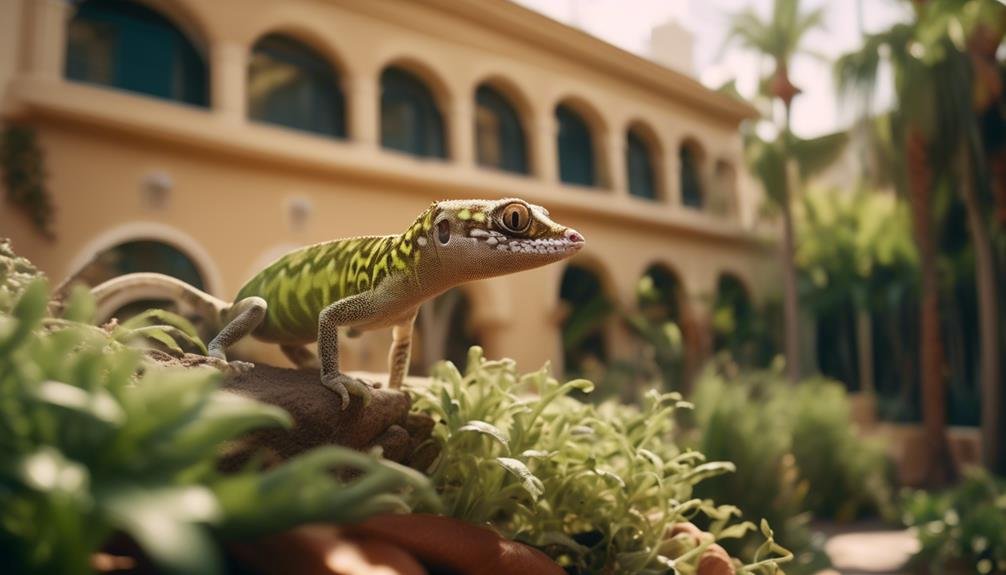
One key aspect to consider when studying the Mediterranean house gecko is its preferred habitat. These geckos inhabit a wide range of environments near human presence, making them highly adaptable. They are typically seen in cracks of old brick buildings, where they find shelter and protection. They can also be found in mountain cliffs, caves, and even trash piles.
In urban or suburban areas, they thrive and can be found nesting in attics or under baseboards of buildings. Mediterranean house geckos are known to be opportunistic in their habitat selection, taking advantage of the resources available to them. This adaptability allows them to successfully establish stable populations in various regions, including the Southwestern and Southern United States.
Behavior and Nocturnal Habits

Mediterranean house geckos exhibit distinct and fascinating behavior patterns, particularly during their nocturnal activities. Here are five intriguing aspects of their behavior:
- Stealthy hunters: These geckos are skilled nocturnal predators, silently stalking their prey under the cover of darkness.
- Wall climbers: With their sticky toe pads, Mediterranean house geckos effortlessly scale vertical surfaces, including walls and even ceilings.
- Vocal communicators: Emitting a high-pitched call, these geckos use vocalizations to communicate with each other, particularly during the breeding season.
- Light seekers: Attracted to outdoor lights, they use these sources to locate and capture their prey, which often includes insects attracted to the light.
- Aggressive protectors: These geckos can display aggressive behavior towards juveniles, defending their territories and resources.
Through their unique behaviors, Mediterranean house geckos have successfully adapted to their new environment, making them formidable invaders in the United States.
Predatory Nature and Diet
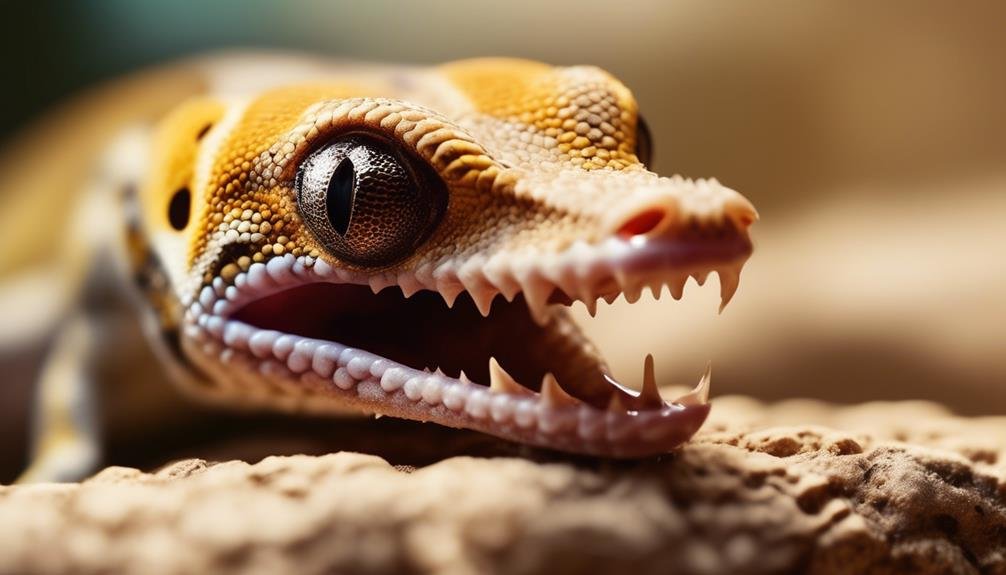
The predatory nature and diet of the Mediterranean house gecko are key factors in its successful colonization and invasion in the United States. As voracious predators, these geckos play an important role in controlling populations of moths and small roaches. Their diet consists mainly of these insects, which they hunt down with their quick reflexes and sticky toe pads.
The geckos are also attracted to outdoor lights, where they can find an abundance of prey. Additionally, they are known to be attracted by the call of male decorated crickets, further expanding their dietary options.
This predatory behavior and adaptability to urban environments have allowed the Mediterranean house gecko to thrive and establish stable populations in the United States, making it a formidable invader.
Attraction to Light Sources

The predatory behavior observed in the Mediterranean house gecko extends to its attraction to light sources, a behavior that contributes to its successful colonization and invasion in the United States. This gecko species exhibits a strong affinity for light, which aids in their search for prey and facilitates their adaptation to urban and suburban environments.
When it comes to light sources, the Mediterranean house gecko displays the following behaviors:
- Lurking near outdoor lights, waiting for insects to be attracted to the illumination.
- Scuttling across walls and ceilings towards light fixtures, driven by their instinctual desire to capture the insects that are drawn to the light.
- Pouncing on insects that have been enticed by artificial lighting, taking advantage of the abundance of prey in these areas.
- Clinging to light bulbs or other sources of illumination, using them as a vantage point to spot potential prey.
- Responding to the call of male decorated crickets, which are known to emit sounds that attract both the crickets’ potential mates and the geckos themselves.
This attraction to light sources is a significant factor in the Mediterranean house gecko’s ability to thrive and expand its territory in the United States.
Reproductive Cycle and Mating Behavior
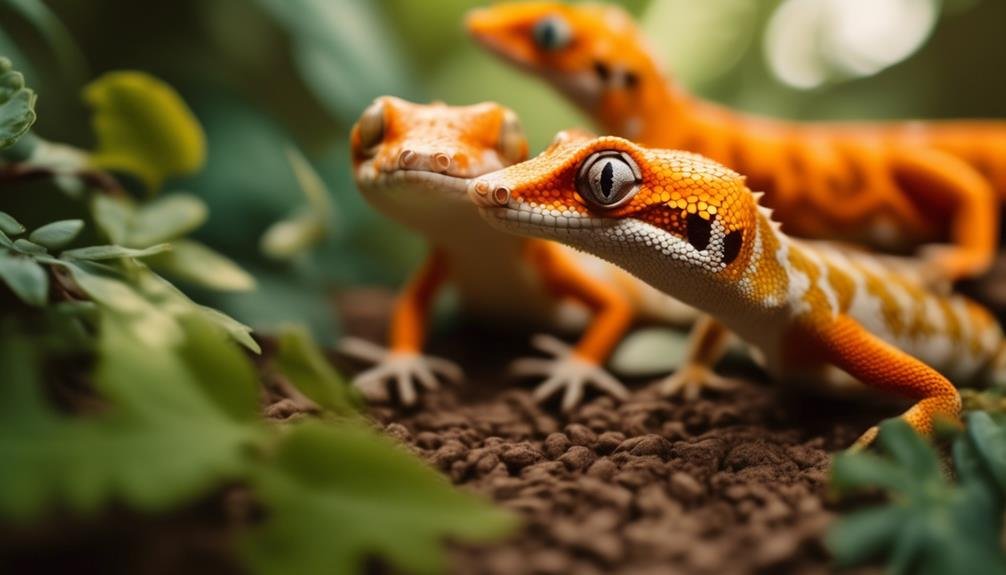
During the breeding season, the Mediterranean house gecko exhibits specific reproductive behaviors and mating rituals.
Males play an active role in attracting mates by producing clicking sounds. These sounds serve as a form of communication and advertisement to potential female partners.
Females respond to the male’s calls with their own squeaks, indicating their interest and availability for mating.
Once a pair has connected, copulatory biting occurs, which serves to increase the chances of successful fertilization.
The breeding season for Mediterranean house geckos typically occurs from April to August.
During this time, females may produce an average clutch size of two eggs.
Understanding the reproductive cycle and mating behavior of these geckos is crucial for managing and controlling their invasive populations in the United States.
Sexual Maturity and Breeding Season
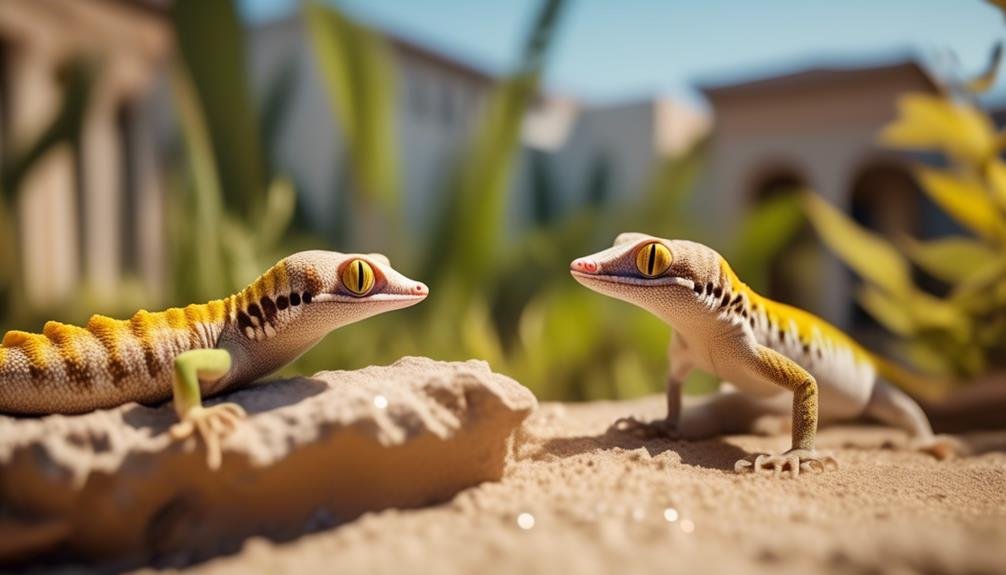
The Mediterranean house gecko reaches sexual maturity within four months to a year of hatching. During this time, they undergo significant physical and behavioral changes in preparation for reproduction. Here are five key aspects of their sexual maturity and breeding season:
- Hormonal changes: As the gecko matures, hormonal changes occur, triggering the development of reproductive organs and the ability to produce eggs or sperm.
- Mating calls: Male geckos produce clicking sounds to attract potential mates, while females respond with their own squeaks to signal their receptiveness.
- Courtship rituals: Geckos engage in elaborate courtship rituals, involving visual displays and physical interactions, to establish mating pairs.
- Copulatory biting: During mating, the male bites the female’s neck or body, which stimulates ovulation and increases the chances of successful fertilization.
- Breeding season: The breeding season for Mediterranean house geckos occurs from April to August, with peak activity during warm summer months. During this time, geckos mate and females lay an average clutch size of two eggs.
Understanding the sexual maturity and breeding season of these invasive geckos is crucial in managing their population and mitigating potential ecological impacts.
Nesting Habits and Locations
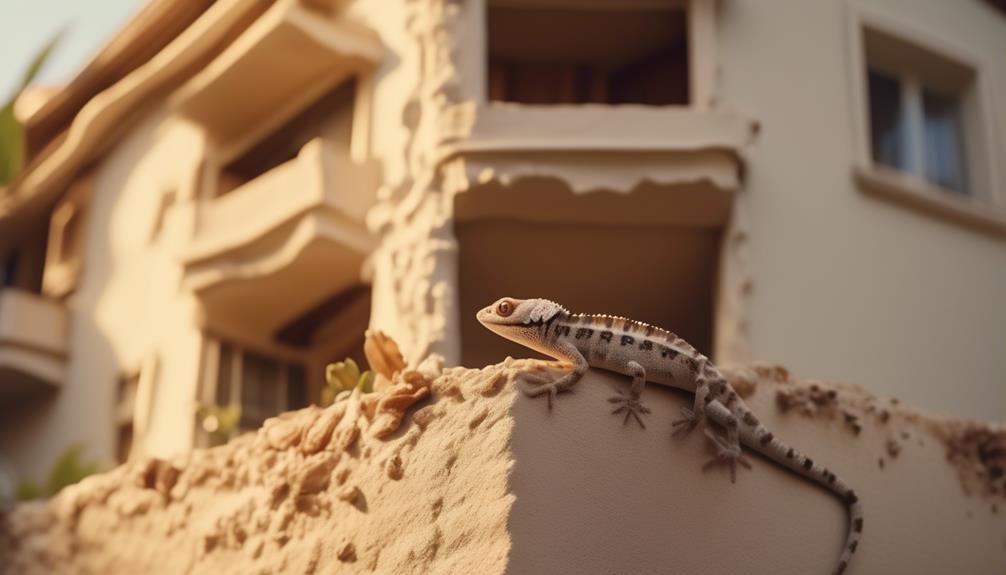
Understanding the reproductive behavior of Mediterranean house geckos is essential. One important aspect to consider is their nesting habits and preferred locations. These geckos are known to inhabit a wide range of habitats near human presence, but they are most commonly found in cracks of old brick buildings. They can also be seen in mountain cliffs, caves, and trash piles.
When it comes to nesting, they tend to choose locations such as attics or under baseboards of buildings. This preference for nesting in man-made structures suggests that they thrive in urban or suburban areas.
It is important to note that their nesting habits and locations may contribute to their successful invasion and spread in the United States.
Recent Invasions in the United States
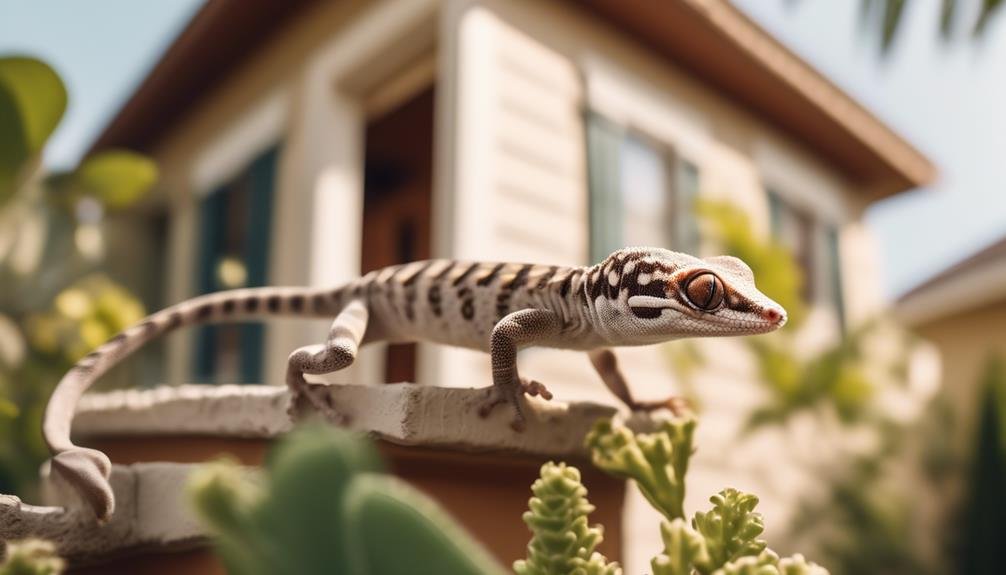
In recent years, the Mediterranean house gecko has become a problematic invasive species in the United States. These recent invasions have caused concerns due to the geckos’ ability to thrive in various environments. These recent invasions highlight the adaptability and invasive nature of the Mediterranean house gecko, posing challenges for local ecosystems and potentially displacing native species.
Here are some key points about the recent invasions of Mediterranean house geckos in the United States:
- Found in states such as Pennsylvania, Tennessee, and Indiana, where they were not previously recorded.
- Have established stable populations in the Southwestern and Southern United States.
- Often seen in cracks of old brick buildings, mountain cliffs, caves, and trash piles.
- Known to nest in attics or under baseboards of buildings, particularly in urban or suburban areas.
- Drawn to outdoor lights in search of prey, making them more visible and noticeable to humans.
Frequently Asked Questions
How Do Mediterranean House Geckos Communicate With Each Other During the Mating Season?
Mediterranean house geckos communicate during the mating season through vocalizations. Males produce clicking sounds to attract mates, and females respond with their own squeaks. Copulatory biting is also observed, which increases fertilization success.
What Is the Average Lifespan of a Mediterranean House Gecko?
The average lifespan of a Mediterranean house gecko is around 5-10 years. However, factors such as predation, habitat conditions, and availability of food can influence their lifespan.
Can Mediterranean House Geckos Harm Humans or Pets?
Mediterranean house geckos pose no direct harm to humans or pets. However, they can become a nuisance in households and may cause damage to property. It is advisable to prevent their entry and remove them if necessary.
Are Mediterranean House Geckos Native to the United States?
No, Mediterranean house geckos (Hemidactylus turcicus) are not native to the United States. They are originally from the Mediterranean region but have spread to various parts of the world, including the Southwestern and Southern United States.
How Do Mediterranean House Geckos Adapt to Urban and Suburban Environments?
Mediterranean house geckos adapt to urban and suburban environments by utilizing a wide range of habitats near human presence, such as cracks in buildings, attics, and trash piles. They are nocturnal predators attracted to outdoor lights and the call of male decorated crickets.
Are Invasive Mediterranean House Geckos a Threat to Native Species in the US as Well?
Yes, common house geckos pose a threat to native species in the US. As invasive species, they compete for food and habitat, leading to declines in native lizard populations. Additionally, they may introduce parasites or diseases to local ecosystems, further impacting native wildlife.
Conclusion
In conclusion, the invasive Mediterranean house gecko poses a growing concern in the United States. With their ability to adapt to a wide range of habitats and their nocturnal predatory behavior, these geckos have established stable populations in various states.
Understanding their behavior, distribution, and reproductive patterns is crucial in managing and preventing the potential ecological and economic impacts of this invasive species. Further research and effective control strategies are needed to address this issue.

